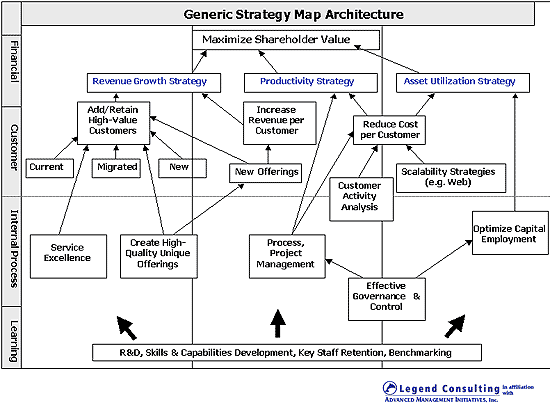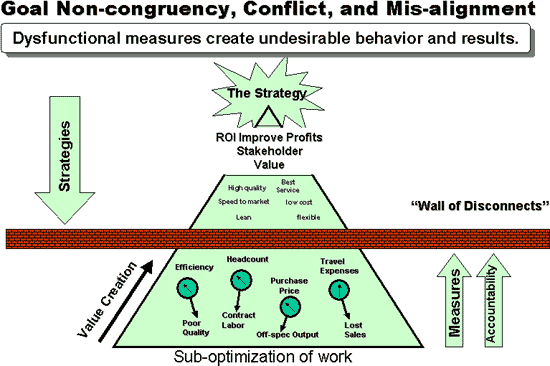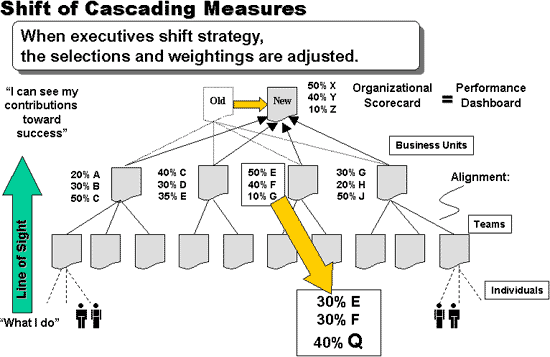
Scorecards: The Link Between Strategy and Execution, Part 1 |
By Gary Cokins and Don Bean |
What Impedes Organizational Performance?
Why is it that so many organizations exhibit so much energy but never seem to get much traction? And why is it that those few who get traction seem to drift off course from their strategy? Some people believe this dysfunctional behavior is because traditional hierarchical command-and-control management structures have changed, but the order fulfillment systems have lagged behind. Their premise is that the business process reengineering rage of the 1990s replaced an outdated organizational structure with process-based management - but without adequate planning and execution systems. Perhaps. But isn't the answer deeper?
Increasingly the blame for poor organizational performance is pointed directly at senior management - their leadership skills. However, senior executives secretly counter that it is not entirely their fault. They believe they have properly re-defined their organizational strategies, but they simply cannot get their organizations to execute in alignment with their strategies. They do not view the problem as being ERP-related but rather people-related.
What do the middle managers and employee teams believe causes the drag on and mis-direction of their organizations? The cynical ones think the strategies may be wrong, but the majority of them see two problems with separate but related causes:
Poor traction - There are too many improvement initiatives, and people are swamped with too many after-the-fact measures inadequately summarized from too much information.
Poor alignment - Few if any truly understand what senior management's strategies actually are. Most managers, if asked, can not articulate them. As a result, increasingly empowered employee teams may have chosen the wrong projects to work on - despite their good intentions.
What is a Solution?
Scorecards are a substantial advance in performance metrics and management that address these problems and more. Scorecards can assure that the visions created at the boardroom level are achieved by the organization. Scorecards communicate strategic objectives to the workforce in terms that are meaningful. The overriding goal of a scorecard system is to make strategy everyone's job. Scorecards are leadership tools that help translate strategies into actions.
But there are organizational obstacles that can hamper applying scorecards.
How Do You Know If You Are Performing Well?
One of the mysteries of the workplace continues to be how to support a manager's claim that, "We did well last quarter." The normal follow-up question is, "How do you know?" Despite a sea of collected data, organizations struggle with making sense of it all. Organizations are generally data rich and information poor. Attempts are being made to fix this with "data warehouses" and "number crunching software." But are those technologies simply Band-Aids™ and medications or a real cure?
When the manager referred to above does state that "we did well," how does the organization detect if the entire organization benefited from whatever that department did when it supposedly "did well?" One way to find out is to improve the organization's measurement system itself. Scorecards improve the measurement system by aligning employee behavior with the goals set in the boardroom or by the governing body. Scorecards, once created, embody the strategic intent of the organization and communicate both the goals the organization intends to meet as well as the critical measures of success in attaining those goals.
A scorecard provides a framework for literally keeping score of the functions and processes that are most important to an organization. Just like at a sports event, a scorecard quickly answers how teams are doing at what matters. Unlike with a sports event, a scorecard system allows managers and employees to keep digging deeper for explanations, to view trends, and to get answers. Measures have measures within measures.
Executive Headaches with Employees
High on the list of the major frustrations of executives is their inability to get their employees to execute their strategies. More specifically, when executives adjust and shift their strategy, they find that their employees continue to perform without much change. Failing to execute a good strategy is a major disappointment in the boardroom and to the governing body. Chief Executive Officers and managing directors usually get blamed.
The massive inertia of the hardened existing measures keeps employees doing what they have been doing. A change in course may not happen despite the executives' appeal. The executives are not particularly interested in employees just getting better at what they have always been doing. They want employees to change their priorities. Getting people to focus on the right things is much more important than improving on things that don't matter.
Another explanation as to why employees do not automatically align their work with strategy is that today's employees are "empowered workers." Unlike many years ago, when employees dutifully obeyed a snap-to-attention command-and-control senior management style, things are different now. Empowerment is a two-edged sword. Empowerment means employees can now choose what they believe they should do but also reject what they think they should not do-regardless of their marching orders. So when today's executives announce new changes in direction for their organizations, today's knowledge-worker employees ask themselves, "Am I persuaded? If not, I continue with my current ways."
To the executives, this is like driving a car with excessive play in the steering wheel. When they turn the steering wheel left or right, the car barely turns. Scorecards are intended to provide precision steering. Like a good golf swing or tennis stroke, scorecards give the follow-through that separates the novices from the professionals.
Scorecards include strategy maps to communicate a unified view of the strategy to the organization. Figure 1 illustrates a strategy map with a flow chart layout.

The strategy map helps employees understand the logic and wisdom of the strategy and how different goals interrelate. More importantly, strategy maps also provide everyone with a line-of-sight of how their individual goals, projects, and accomplishments contribute to the overall strategy and objectives - and eventually to the success of the organization.
It can be mind boggling to understand the generational tree-branch-leaf relationships of how senior management's vision turns into strategies that turn into sub-strategies to projects to the tasks that actually turn the gears. Many of the relationships are broken or ineffective. Similar to the parlor game of "telephone message" whispered along a chain of partiers, something always gets lost or distorted. Organizations are no different. Scorecard software systems resolve this constant nuisance by de-composing each of senior management's multiple strategies into smaller components comprised of the appropriate projects and tasks - the work that people and equipment do. Decomposing strategy in this way enables assignment of smaller components of strategy to departments, task-oriented groups or individuals. This apportioning of strategy completes the linkage of high-level strategies to individual actions. You can also think of this as a chain of linked scorecards - each based on common scorecard principles - that cascade from top-level headquarters to the front-line workers.
Accountability, Responsibility, and Ownership
In the end, performance measures are intangibles that themselves can not push buttons or pull levers. The utility of performance measures is proportional to how well they influence people to do the right things. That may sound profound, but it is true.
Scorecards have tremendous analytical capability, but their real power is as a management application that can coordinate the efforts of large numbers of people. Scorecard software allows each manager and employee to customize their own individual scorecard and, subject to security and policy, to have access and visibility to other scorecards. This fosters discussion about common or shared interests and problems. In addition, within each scorecard, multiple custom views can be constructed to track many different measurable objects.
Ultimately a single employee has to be held accountable for progress and results. As organizations become increasingly matrixed to support cross-department processes, projects, and initiatives, identifying and locating that person who is ultimately responsible for a goal or measure becomes tricky. Scorecard software solves this by assigning discrete ownership of goals and measures throughout the system and eventually into the organization's mindshare.
In the early stages of automated scorecard systems, providing mouseclick convenient e-mail access to measurement owners (and to others) was added as software feature of minor importance. Surprise! The human nature desire to immediately contact and communicate as one is viewing and analyzing performance data has quickly become one of the most popular features of a scorecard software system. In a few pages this paper further addresses the human nature side of scorecards when it discusses the topic of collaboration.
Poor Alignment of Strategies and Measures
Promoting a better understanding of strategies and their linkages to goals is important, but selecting the correct specific measures and their expected target levels is also critical. One of today's organizational problems is the disconnect and absence of alignment between local measurements of things a manager, team, or employee can control or influence and the subsequent organizational results. Worse yet, in many cases the measures in place today tend to be internally "competing" measures that result in employee behavior such as, "As I do well, I adversely affect your measures so you do poorly"-classic sub-optimization. Figure 2 reveals how dysfunctional measures create undesirable behavior and results.

The new thinking associated with scorecard systems directly connects local employee behavior to the organization's strategies and goals. Two attractive aspects of this new thinking are:
An increasing emphasis on nonfinancial measures, such as customer satisfaction and employee innovation, and
A greater focus on predictive measures (leading process indicators) in contrast to after-the-fact historical results that are reported too late to change the outcomes (lagging results indicators).
A scorecard modeling environment allows for completely customized scorecards with an unlimited number of strategies, objectives, key performance indicators (KPIs), critical success factors, perspectives, or themes. Both numeric and text based or subjective measures are supported providing the greatest possible flexibility in designing a performance tracking system.
Unlike a trickle-down-the-ranks method of management, scorecarding is more of a trickle-up phenomenon. In order to produce good results, the expected performance measures should reflect solid top-down planning, but the results--good or bad--will come from bottom-up performance.
In short, if the measures selected are those that align employee behavior to desired outcomes (e.g., meeting strategic goals), then the near-attained target measures will be met. And since the target measures, popularly called key performance indicators (KPIs), are derived from the strategy planning, this means the strategy itself is being achieved.
In sum, the need for reforms with organizational measures reflects the inability of senior management to communicate strategy changes and get their organizations to execute in alignment with revised strategies. In addition, excessive emphasis on financial measures, like bottom-line profits, involves lagging indictors reported too late. To senior managers, managing financial results is like pushing a rope-it is hard to do. Leading indicator measures are more important because they are predictive of high-level goal achievement and financial outcomes.
Scorecard Software Systems
In complex environments, it is no simple task to identify owners of goals, select the correct measures, give each measure the right level of emphasis, assign a reasonable level of performance, and then monitor the results. In the past, to complicate matters, there was little in software technology to support methodologies of performance measurements. Some advocated chalkboards prominently displayed in the cafeteria, while others harnessed mainframe computers to generate reams of paper stuffed through the mail to people who may not see it for a week.
But now times have changed. Information technology is no longer the impediment - the thinking becomes the main problem. Software and communication platforms now ease the selection, configuration, data collection and distribution of measurements. Internet delivery via web-browsers to individual's personal computers is now very practical (and discussed later). But poor measure selection can lead to unintended and poor results.
Scorecard software systems can support widely accepted measurement methodologies such as the Balanced Scorecard or criteria laid out in the USA's Malcolm Baldrige Award or the European Foundation for Quality Management (EFQM). Regardless of the number of "views" or "perspectives" measured (e.g., customer, internal processes, innovation, etc.), scorecard software provides a multidimensional framework for describing, implementing, and managing strategy at all levels of an enterprise. This is accomplished by linking objectives, initiatives, and measures to an organization's strategy. Scorecards provide an enterprise view of an organization's overall performance by integrating financial measures with other key performance indicators around whatever perspectives (e.g., customers) are deemed important.
Too Many Measures Reduce Focus
Another problem with conventional performance measurement systems relates to too many measures. You cannot just dump a hundred measures like children's blocks on a table and instruct employees to do well on all of them. Some measures have more impact on results than others. When an organization focuses on fewer, more vital measures, it gets better traction.
The mantra for scorecards is the answer to a simple question: "How am I doing on what is important?" This question should be answerable at every level of the organization - from the operational teams to managers to directors up to the governing bodies in the boardroom.
Unfortunately, not only do organizations not distinguish among measures in terms of their relative importance, but they also often assign managers or employee teams too many measures. To complicate matters, many of these measures are not within their immediate influence or control. How fair is it for you or your team to be judged by measures that result from the performance of others? Management may think that this will motivate teams to pull together and help each other out, but is that practical? Isn't that being presumptuous?
Monitoring too many indistinguishable measures outside peoples' control dilutes the impact of bothering to measure anything. The organization winds up operating without a compass. How do you fix this situation? Some experts believe that people or teams can handle at most only three measures. And they must be able to significantly influence and control the results of those measures. When this approach is used, the emphasis shifts to the selection of the correct measures.
Figure 3 illustrates how "local" measures can be selected and cascaded downward for teams, and results can then be rolled up and aligned with the organization's strategy. These cascaded measures are parallel to the strategy maps. Figure 3 provides an example of how an employee can have the line of sight on how what he or she does can affect other performances that eventually affect achieving the strategic goals. Employees can see how they contribute to the organization's success. If management is bold, they will allow the employee teams to see how the others are contributing to success.

Note in Figure 3 how the bottom-level measures lend themselves to monitoring from an activity based cost management (ABC/M) system. At the end of this article, we will discuss ABC/M as a supplement to scorecards.
Carrying the performance measurement methodology throughout an organization requires adoption of the principles of scorecarding at all levels. Scorecard software enables the creation and management of scorecards at any level in the organization. This proliferation of scorecards throughout the organization results in a top down cascade of performance measures that links the highest-level vision and strategy with the actions at the tactical level where strategies are really implemented by the day-to-day activities of individuals.
Figure 4 illustrates the overall idea that the more operational leading indicators at the employee team level should be measured more frequently. The higher-level lagging indicator results, measured less frequently, should respond in synchronization presuming there is a reasonable level of correlation. How do organizations fine-tune the selection of their measures? They do it with an on-going scorecard system that allows the flexibility to remove, add, substitute, and reconfigure how the KPIs relate to strategies. Unfortunately, most organizations are usually so pre-occupied with trying to steer the organizational ship through the high seas, they have not implemented the platform - the navigational system and compass - to facilitate fine tuning let alone steerage.

Figure 5 visually reveals the decomposition and cascading of a top-level strategy to a front-line action. Figure 5 illustrates that when the senior managers shift strategy, they can: (1) replace a measure or two of the vital few measures with different and more applicable measures, and/or (2) rebalance the weightings of emphasis for the measures.

Rebalancing the weightings by modifying the coefficient percentages is like an airline pilot slightly adjusting the ailerons on the wings to slightly alter the plane's course. But replacing an old measure with a new one is more intense--like banking the plane left or right.
This ends Part 1 of 2